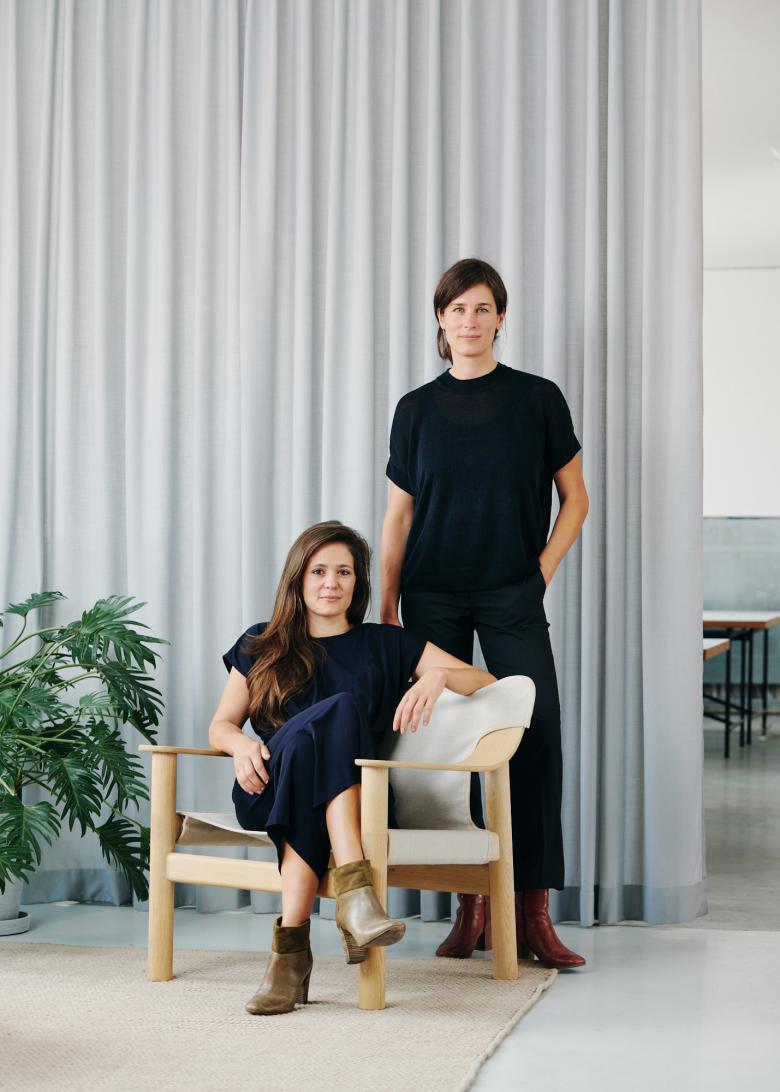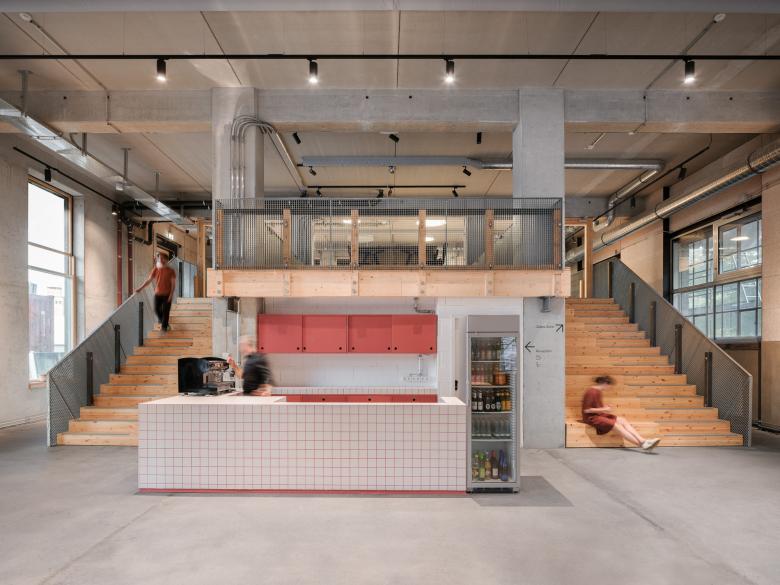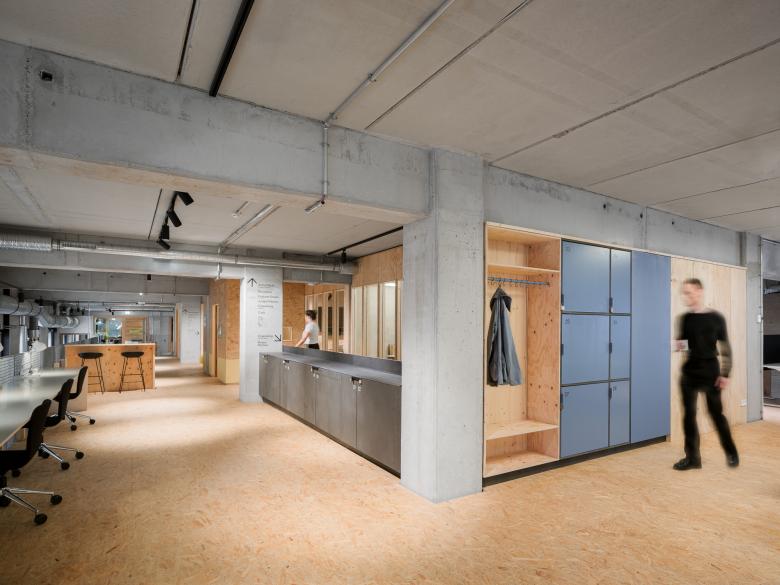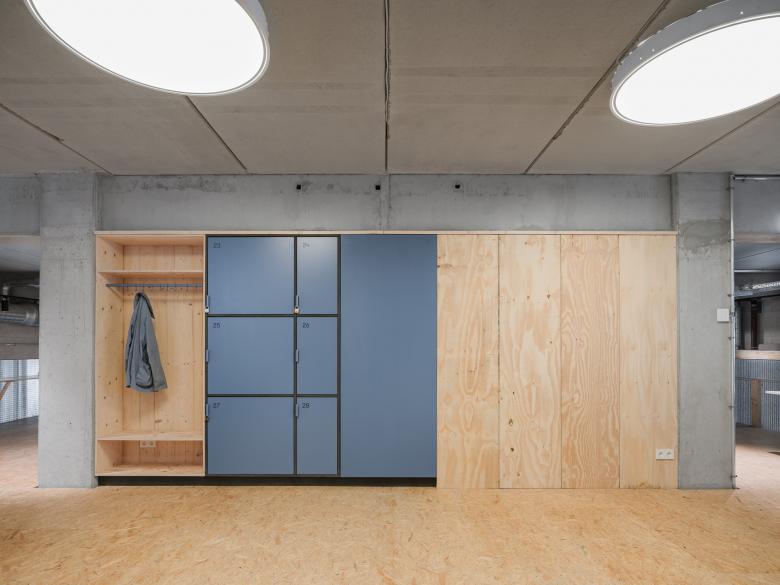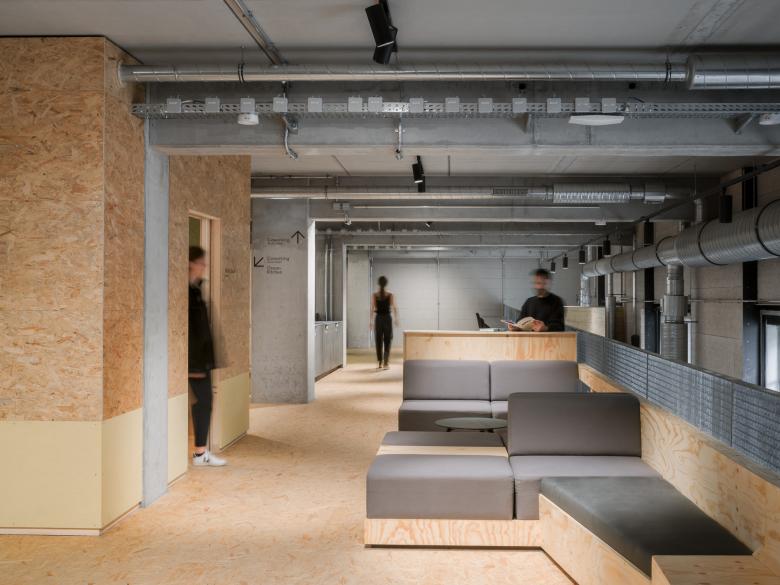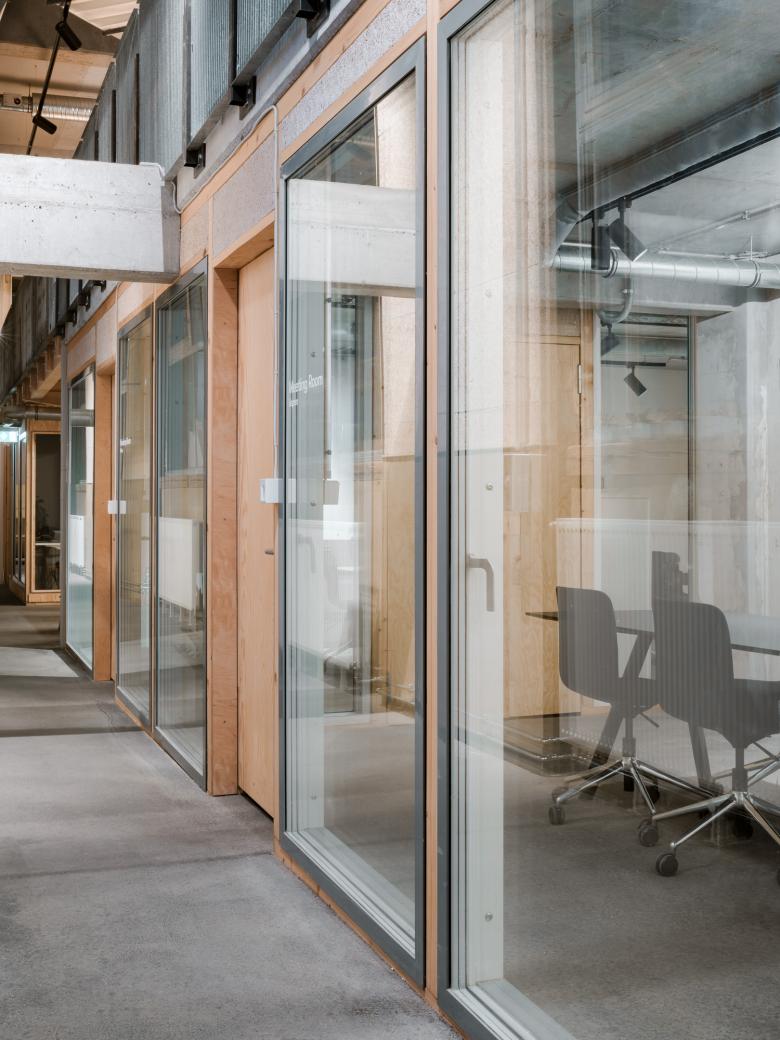Margit Sichrovsky and Kim Le Roux: 'Circular construction does not work without a circular economy. We need new business models.'
Elias Baumgarten
18. August 2022
Kim Le Roux (left) and Margit Sichrovsky (Photo: Hannes Wiedemann)
The Berlin-based architects are concerned with the establishment of a circular economy in the building industry. In this interview they talk about working with used building components and the development of the German capital between awakening and stagnation.
Margit and Kim, I perceive your adopted home city of Berlin as one of the architecturally, socially, and culturally most interesting metropolises in Europe. The challenges there are enormous: The need for new housing is great; the rents are no longer affordable for many. At the same time, new construction should be climate-friendly and ideally as limited as possible. How do you assess Berlin's development?Margit Sichrovsky: In our city there is a big discrepancy between very innovative projects on the one hand and a lot of mediocre architecture on the other. The Senate has launched great initiatives for circular construction. There is definitely the political will to build in an ecologically and socially sustainable way. But at the same time, Berlin is stagnating architecturally: Many new buildings are boring, sometimes uninspired, and also implemented cheaply. Project developers have new buildings sprouting up all over the place that are not very innovative in terms of design. Their floor plans are stuck in old-fashioned ideas, they hardly reflect the changes in our society. Unfortunately, these projects make up the bulk of new buildings.
Kim Le Roux: There are joint building ventures and initiatives that are producing lighthouse projects. In recent years trend-setting timber buildings and innovative urban quarter developments have been implemented in Berlin. In addition, cooperative processes have been designed — just think of the Haus der Statistik or Dragonerareal. Apart from that, new forms of housing are being tested, and there are exciting neighborhoods, for example in the residential complex on Briesestrasse by EM2N. There are also various projects trying to get the circular economy going, such as Impact Hub Berlin on the site of the former Kindl Brewery in Neukölln. Impact Hub Berlin is a co-working space for companies specializing in circular economy, sustainable food and green technology, as well as for organizations with a social focus. This conversion project is headed by the non-profit developer TRNSFRM, which is carrying out the refurbishment and vertical extension of the existing building according to the designs of Die Zusammenarbeiter. Following the principles of sustainable and circular construction, we designed and implemented the interior fit-out in a collaborative process with the client Impact Hub Berlin and all project stakeholders. Working with used components and recycled materials, we developed structures that are reversible and can be adapted to the requirements of new uses in the future. The first construction phase was recently completed and the first users have moved into their offices.
KLR: Yes, for example Concular, which is committed to the reuse of components and materials, from inventory to brokerage and the issuing of material passports. But we also searched for used components ourselves and learned a lot in the process. For example, linear planning along the HOAI service phases 1 to 9 is less suitable for such a project. More flexibility is needed in the design process; the design has to be adapted depending on what materials can actually be procured. For example, we used a small grid after realizing that wood panel materials are available in large quantities but only in small dimensions.
MS: Building component exchanges should only be an interim stage. Circular construction does not work without a circular economy. We need new business models. In the future, manufacturers must think about the entire cycle. They should collect their products when they are no longer needed, refurbish and then offer them all over again. A few companies have already adopted this approach for themselves: At Impact Hub Berlin, for example, we worked with a glazier who removed old glass, cut it to new sizes, and reinstalled it.
Impact Hub Berlin at the CRCLR House (Photo: Studio Bowie)
Photo: Studio Bowie
How do used components affect the design? Does this result in the development of a new architectural vocabulary?MS: Architecture is principally in a constant state of flux; it is constantly changing. We actually believe that recycling will lead to aesthetic changes. However, this does not mean that buildings will have to look second-hand and used in the future. After all, the better the logistics, i.e. the more old components are available, the greater the choice and design options. We find it interesting that used components have a history that can be reactivated. You might even find elements that were previously installed in the same place. This makes it possible to develop a strong identity-forming architecture. That's important because many people have a great longing for stability and roots.
KLR: When we designed the interiors of the Impact Hub Berlin, the connection points were an important issue for us. In the end, we developed details where the connections stand out very clearly. In many cases you can immediately see where parts are bolted together. This makes it clear to users how they can make changes or replace elements themselves. This increases their participation in the architecture. And indeed, the users of the first construction phase have already made adjustments and added parts for better acoustics, for example.
Photo: Studio Bowie
Photo: Studio Bowie
Let's come back to Berlin's development. Recently, important decisions have been made there in terms of construction policy. In Switzerland, we have been particularly aware of the heated controversy surrounding Petra Kahlfeldt. There was an open letter to Berlin's Governing Mayor Franziska Giffey (SPD), calling for an independent professional commission. Hundreds of architects had signed it, along with developers, politicians, artists, and personalities from the cultural sector. You signed it too, Margit. Why?MS: That was a very emotional debate, causing a big outcry among our colleagues. Kim and I got to know and appreciate Regula Lüscher. She brought a breath of fresh air to Berlin. Petra Kahlfeldt is part of the old guard that was responsible for the city's architectural development under Hans Stimmann before Regula Lüscher took office. I think that her appointment has disappointed younger architects in Berlin, because Stimmann and his former comrades-in-arms, like Petra Kahlfeldt, stand for a very different Berlin than the one we imagine. Their goal is the restoration of a historical version of the city. We, on the other hand, are interested in ecological and social issues of the future, not in a sentimentalized past. We don't need a backlash in Berlin.
MS: Meanwhile, we are experiencing Petra Kahlfeldt as more open-minded. She faces up to critical questions. The BDA Berlin initiated the Stadtgespräche, a three-part series of public discussions with Petra Kahlfeldt. I see potential in her determination to preserve the existing building stock. If that refers not only to architectural monuments but also to other buildings, that would be positive in terms of sustainable building. We always ask ourselves first what we could do with the existing building before building something new. Now we hope Petra Kahlfeldt might take a similar view. It remains to be seen, however, whether forward-looking solutions can actually be found for the existing building stock. Can Petra Kahlfeldt create a good environment for this or will conservative circles prevail in the end?
KLR: There is currently great potential to rethink the city in a sustainable way. In view of climate change, this is absolutely necessary. Cities can and must play a decisive role here. What makes Berlin special is the commitment of the population and their willingness to take to the streets, for example, to stand up against investor architecture. There is a strong will to create neighborhoods and to get involved. At the same time, as in many large cities in Europe, we have problems with isolation and loss of identity. This is where Petra Kahlfeldt could come in and strengthen the different neighborhoods. She could support joint building ventures, collectives and cooperatives and enable them to create contemporary architecture.
MS: It is important to preserve the existing buildings and find innovative solutions in the process. This might well be complex, such as converting office buildings into residential buildings or creating new hybrid uses. Unfortunately, the legal framework is often not in place.
KLR: And why is it that we always have to have the final solution right away? Why can't we test different ideas? In the Bergmannkiez in Kreuzberg and on Friedrichstrasse in Berlin-Mitte, the test runs for traffic calming were both successful.
Photo: Studio Bowie
Photo: Studio Bowie
After the last federal election, a Federal Ministry of Construction was established in Germany. Does this mean that there is a growing awareness among politicians and large sections of the population of how big a part the construction industry plays in the climate crisis, but also of how much it can contribute to solving it? Until now, the focus has been more on topics such as mobility, travel, consumer behavior, agriculture and nutrition.KLR: We hope so. But it seems that the German government is primarily concerned with alleviating the rampant housing shortage. At the moment, numbers of new apartments are being announced in Germany that are at odds with the climate targets. Our chancellor, Olaf Scholz, promised 400,000 new residential units per year. Yet it is questionable to come up with figures without saying how large the apartments should be or how new building area can be gained without more soil surface being sealed. What would be important here is to examine the existing stock, even in conurbations, for potential residential use and to densify it. In the case of new buildings, attention must be paid to quality and sustainability to ensure that they are not demolished in thirty years.
MS: That's right! There has to be a broad social debate on the subject of sufficiency, otherwise nothing will change. Everyone has to question their own demands and habits, including myself, of course. We listened to Klara Geywitz, the newly appointed Minister of Construction, in Nuremberg at the BDA Days. Her speech pointed in the right direction; she has good ideas. Now we have to wait and see what she can achieve and, above all, how much money she really has at her disposal.
Photo: Studio Bowie
Photo: Studio Bowie
Do we need greater financial incentives for ecologically and socially sustainable housing construction in Germany? Patrick Lüth, who heads Snøhetta's studio in Innsbruck, suggested in an interview that developers who take a holistic approach to sustainability should be granted preferential financial conditions. He said, for instance, that those that demonstrate low overall CO2 emissions could be allowed a higher density or granted tax benefits.
KLR: Financial incentives are absolutely necessary, because without them hardly anyone in the construction industry sees any reason to develop new products. Perhaps the EU taxonomy that came into force this January will be helpful here. It makes it more transparent whether companies are operating in an environmentally friendly manner or not. This should steer investments and put a stop to greenwashing. I'm convinced that we can't just wait for a change in thinking, especially since we're dealing with an army of lobbyists in the construction industry who are spreading the fairy tale that sustainable materials are generally more expensive. They want us to continue building as we have for the last twenty years.
MS: Actually, we already have strict regulations in Germany, but there are too many exceptions. Although we have a large number of quality seals, it is easy to find a loophole and still not build sustainably. On top of that, many certifications are in private hands. This is wrong. How can it be that the private sector uses certificates that concern society as a whole to maximize profits? This must be changed. The rules must gradually become stricter. France, for example, is a step ahead. From 2025, it will no longer be possible there to rent out buildings with particularly poor sustainability. Investors thus understand that they will soon only be able to generate rental income with environmentally friendly buildings.
KLR: Perhaps we even have too many certificates. This can also block innovative solutions and lead to excessive technical complexity, for example in building services. What we need is a uniform system of material passports throughout Europe. Then we could save ourselves a lot of certificates. Our buildings should have a clearly quantifiable material value. That could promote a different mindset among investors.
MS: Building material will become scarce in the future. Nevertheless, it is cheap today compared to labor. Anna Heringer recently said that material should be taxed instead of labor, as before. I fully agree with that. As I said earlier, a functioning circular economy and an environmentally friendly, sparing use of resources require a new economic system.
Photo: Studio Bowie
Let's change the subject once again and talk about your careers. You started your own business very soon after completing your studies. That surprised me, because we always hear that it's extremely difficult for young architects in Germany to set up their own office; due to the competition system, for example, which puts young designers without references at a disadvantage.KLR: After graduating, we gained professional experience for a few years, so that we had worked on service phases 1 to 9 at least once. That is important. After we founded our office, we participated in only a few competitions. Instead, we implemented interior designs for young startups. We then grew organically with these companies, and interior design evolved into high-rise construction. One should break away from old thought patterns and beliefs. Architecture too needs more new work and fresh ideas in terms of business models.
MS: Our hierarchy is flatter than in a classic architecture firm. Our employees design as much as we do. We are on an equal footing with each other. It would certainly help if we all scaled down our sometimes big architectural egos.
MS: I am with you on that. But would you also ask us this question if we were two young men? Up to now, it has unfortunately been the case that questions about education and care work have been directed at women. But they concern everyone, men included. By the way, I also think it's a shame that young men who participate in care work and look after their children are hardly made visible — probably because they don't correspond to an image of masculinity that is still anchored in many people's minds. We need them as role models.
KLR: In architecture and in construction, we often have to deal with sexist stereotypes that you might think are relics from the past. I've often heard that women are too emotional to do the job. An outdated concept of masculinity is still idealized. But you're not an esteemed person to be respected because you yell like a hothead. We don't try to be like men. We are women and have our own approach. Different people add value in different ways. We need more diversity and openness.
MS: I'd like to add something on the subject of stereotypes: Kim has just explained that we started with interior design. In the meantime, we have found that it is very difficult for us as women to get out of this corner. For example, we are entrusted with all kinds of workshops, but in the end the "real" architecture commissions are always reserved for the usual men. Unfortunately, we often get the impression that young women are considered to be less capable. Even though they are statistically more industrious and have better final grades. This is frustrating. There is still a lot to be done in society as a whole. Where could we begin? Perhaps the toy stores are indeed a good starting point.
Kim Le Roux studied architecture at UCT in Cape Town (RSA) and at TU Berlin. Influenced by her childhood in South Africa, she sees the creation of architecture as a way to contribute to social justice. In 2021, she was appointed a member of BDA Berlin.
Margit Sichrovsky studied architecture at the Bauhaus-Universität Weimar and at the TU Berlin. For her, social requirements are always paramount, as is the question of what influence architecture has on the immediate environment and on each individual. In 2021, she was appointed a member of BDA Berlin. Since 2022 she has been part of the working group Sustainable Planning and Building of the Berlin Chamber of Architects.
Kim Le Roux and Margit Sichrovsky founded LXSY Architekten in Berlin in 2015. As architects, the team members are concerned with the question of how we as a society want to live and work together in the future. For their projects, LXSY Architekten have won the German Design Award 2017 and the Iconic Award 2019, among others.
